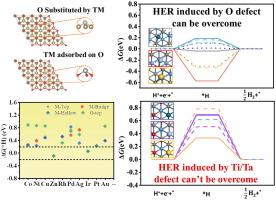基于二维过渡金属碳化物的CO2RR催化剂的设计原理
IF 13.2
1区 工程技术
Q1 ENGINEERING, CHEMICAL
引用次数: 0
摘要
由于大气中二氧化碳的超常增加造成了灾难性的环境后果,因此对将二氧化碳转化为增值化学品的可持续和清洁技术的需求很大。二维过渡金属碳化物和氮化物(MXenes)由于具有与贵金属相似的催化性能和独特的二维结构,在催化领域具有广阔的应用前景。然而,由于HER与CO2RR之间复杂的竞争关系,设计出具有满意催化性能的MXenes基CO2RR催化剂仍然是至关重要的。在本研究中,提出并全面讨论了用于CO2RR的MXenes的设计原则。基于对CO2RR性能优于Ti3C2O2_Ov的误导性发现,提出了制备高效MXenes基CO2RR催化剂的理想M3C2O2结构必须具有高ΔG(*H)的前提。此外,研究了关键反应中间体在一系列晚期过渡金属取代的Ta3C2O2 MXenes上的吸附行为以及吸附物与催化剂之间的电荷转移。随着取代金属用量的增加,不同金属对CO2RR和HER的催化作用表现出不同的趋势。此外,一旦形成Ti或Ta空位,HER比CO2RR更有利,这需要温和的方法来合成MXenes基CO2RR催化剂。本研究提出的设计原则和趋势可用于指导高效MXenes基CO2RR催化剂的理论设计和实验制备。本文章由计算机程序翻译,如有差异,请以英文原文为准。

Design principles of two-dimentional transition metal carbides based CO2RR catalysts
The sustainable and clean technologies for converting CO2 into value added chemicals was in great demand due to the catastrophic environmental consequences caused by the extraordinary increase of atmospheric CO2. Two-dimentional transition metal carbides and nitrides (MXenes) are promising candidates in catalytic applications benefited from the similar catalytic property with precious metal and the unique two-dimentional structure. However, it was still crucial to design MXenes based CO2RR catalysts with satisfying catalytic performance due to the complicated competing between HER and CO2RR. In this study, the design principle of MXenes for CO2RR was proposed and discussed comprehensively. The premise that the ideal M3C2O2 structure should have high ΔG(*H) for fabricating efficient MXenes based CO2RR catalysts was proposed based on the findings on the misleading superior CO2RR performance over Ti3C2O2_Ov. Furthermore, the adsorption behavior of key reaction intermediates together with the charge transfer between adsorbate and catalysts were investigated over Ta3C2O2 MXenes substituted by a series of late transition metal. With increasing the amount of substituted metals, different metal displayed different trend in catalyzing CO2RR and HER. Moreover, once the Ti or Ta vacancy was formed, HER was more favored than CO2RR, which required the gentle method for synthesizing MXenes based CO2RR catalysts. The proposed designing principles and trends obtained in this study can be applied in guiding the theoretical design and experimental fabrication of efficient MXenes based CO2RR catalysts.
求助全文
通过发布文献求助,成功后即可免费获取论文全文。
去求助
来源期刊

Chemical Engineering Journal
工程技术-工程:化工
CiteScore
21.70
自引率
9.30%
发文量
6781
审稿时长
2.4 months
期刊介绍:
The Chemical Engineering Journal is an international research journal that invites contributions of original and novel fundamental research. It aims to provide an international platform for presenting original fundamental research, interpretative reviews, and discussions on new developments in chemical engineering. The journal welcomes papers that describe novel theory and its practical application, as well as those that demonstrate the transfer of techniques from other disciplines. It also welcomes reports on carefully conducted experimental work that is soundly interpreted. The main focus of the journal is on original and rigorous research results that have broad significance. The Catalysis section within the Chemical Engineering Journal focuses specifically on Experimental and Theoretical studies in the fields of heterogeneous catalysis, molecular catalysis, and biocatalysis. These studies have industrial impact on various sectors such as chemicals, energy, materials, foods, healthcare, and environmental protection.
 求助内容:
求助内容: 应助结果提醒方式:
应助结果提醒方式:


